An experiment with the installation of an aviation machine gun ShKAS on a floating tank T-37A
It is worth noting that in the Soviet stories there were successful examples of such an interaction. In a very difficult period for the country, when German soldiers stood near Moscow, and the Red Army lost almost all of its tanks, not very perfect and very simple light tanks T-60, which Soviet industry mastered in a short time, played a very important role. These combat vehicles were armed with a 20 mm TNSh gun, which was a tank version of the ShVAK aircraft gun. The cannon was originally developed as an aircraft, the designers did not plan to install it on ground combat equipment, but in the conditions of war they were able to adapt it for installation on a light tank in a short time. But the first attempts to install aviation weapons on the tank were made in the Soviet Union before the start of World War II.
Back in 1930, in the USSR, the country's first machine gun, designed specifically for aviation, was the 7,62-mm ShKAS (Shpitalnom - Komaritsky Aviation Rapid Fire). He became the first Soviet high-speed synchronous aviation machine gun. Produced serially from 1932 to 1945, when new models replaced it. Especially for the ShKAS machine gun, new aircraft cartridges of increased reliability with armor-piercing incendiary and armor-piercing bullets were created. The machine gun was put on all Soviet aircraft that were launched from 1934 to 1941, and was used in all armed conflicts involving the USSR, from the Spanish Civil War to the battles of the Great Patriotic War. The machine gun was produced in the wing, turret and synchronous versions.
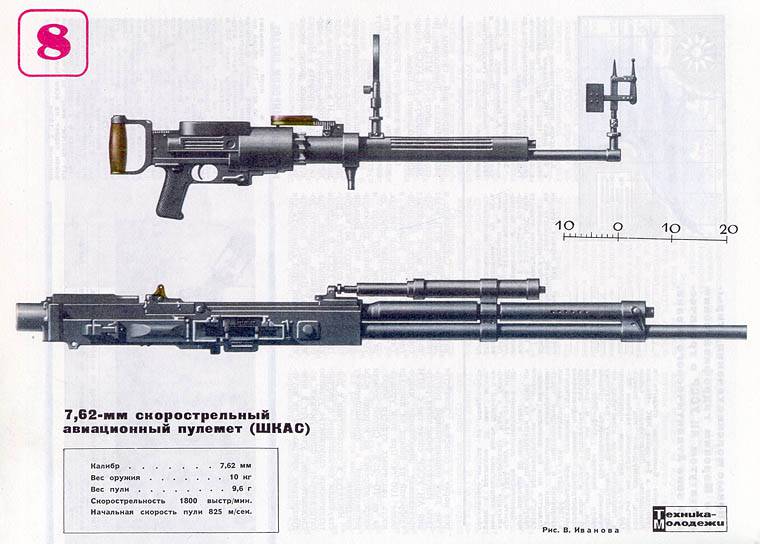
ShKAS was the first in many ways. The PV-1 Nadashkevich and DA Degtyarev machine guns that preceded him represented the development of the experience of the First World War - adaptation of the Maxim and DP infantry machine guns for aviation purposes. At the same time, ShKAS became the first full-fledged aviation machine gun that met all the requirements of the time. The multicore returnable spring and the continuous feed of the tape - all this was implemented in ShKAS for the first time. As well as the first time in a single-barrel machine-gun system, it was possible to achieve such a high rate of fire - 1800 shots per minute. According to this indicator, the machine gun was not equal in the whole world.
So, the German 7,92-mm machine gun MG-17 (tape feed) provided the rate of firing of 1100 rounds per minute, 7,62-mm French aviation gun "Darne" (tape) - 1100-1200 rounds per minute, American 7,62-mm Colt-Browning "(Tape) - 900 shots per minute, English 7,7-mm" Vikkers "-R (store) - 1000 shots per minute. The main "highlight" of the Soviet machine gun was its power system, which allowed to achieve such a high rate of fire. ShKAS machine gun had a high rate of fire due to the short course of the moving parts of automation, as well as reducing the time it took to reload operations, due to their combination.
Tactical and technical characteristics of the ShKAS machine gun:
Caliber - 7,62 mm.
Cartridge - 7,62x54R
Weight - kg 10,5 (turret version)
Rate of Fire - 1800 shots / min.
The initial speed of the bullet is up to 825 m / s.
Power system - tape.
In the 1935 year, the GAU (Main Artillery Directorate), at the request of the GABTU (Main Automobile and Armored Directorate), carried out a number of works to create a ball mount for the ShKAS aviation machine gun, as well as to refine the machine gun and its possible installation on the T-37А light tank. The combat unit was supposed to turn out to be unique, having absorbed three elements at once: a amphibious tank armed with a high-speed aviation machine gun. At 1936, the year was planned for an even more impressive amount of work. It was supposed to equip ShKAS turret systems as anti-aircraft weapons practically all armored vehicles: T-26, T-28, T-29, BT-7, T-35, T-46 tanks and the BA-3 armored vehicle, and also use the SKKAS for arming armored vehicles and install on the basis of the tractor STZ-3. In addition, it was proposed to replace the ball mount for the DT-29 with a similar one, but under the ShKAS, in the towers of the T-28 medium tank and the heavy T-35 tank. Ultimately, these plans did not succeed in being fully realized.
And yet on the floating tank T-37A machine gun ShKAS managed to put. T-XNUMHA became the first in the USSR serial amphibious tank. The tank was created in 37 year on the basis of the English amphibious tank of the Vickers company and the already existing Soviet prototypes of amphibious tanks. The combat vehicle was mass-produced from 1932 to 1933. During this time, 1936 tanks of this type were assembled in the Soviet Union. In the Red Army, they were assigned the role of the main reconnaissance tank. The T-2566А was designed to carry out reconnaissance, communications, combat support of units on the march, as well as direct fire support of infantry on the battlefield.
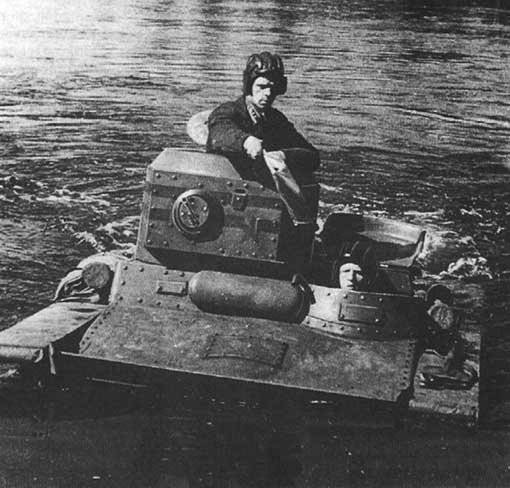
The floating tank T-XNUMHA had an unusual layout for most of the Red Army tanks, but for the Soviet 37 tank tanks it became a classic. The control unit was located in the middle part of the corps and was combined with the combat and engine compartments. In the forward part of the tank hull there was a transmission compartment. In the stern of the hull there was a compartment with a fuel tank, cooling systems and a propeller drive, which provided the possibility of movement through the water.
The crew of the amphibious tank consisted of 2 people: driver and tank commander. The place of mechvod was located in the left part of the tank hull in the control compartment. The commander of the combat vehicle was located in the turret, which was shifted from the longitudinal axis of the tank to the right. In battle, he could conduct surveillance of the terrain through viewing devices, and also fired from a turret machine gun. If the combat vehicle was equipped with a radio station, it also had to perform the functions of a radio operator.
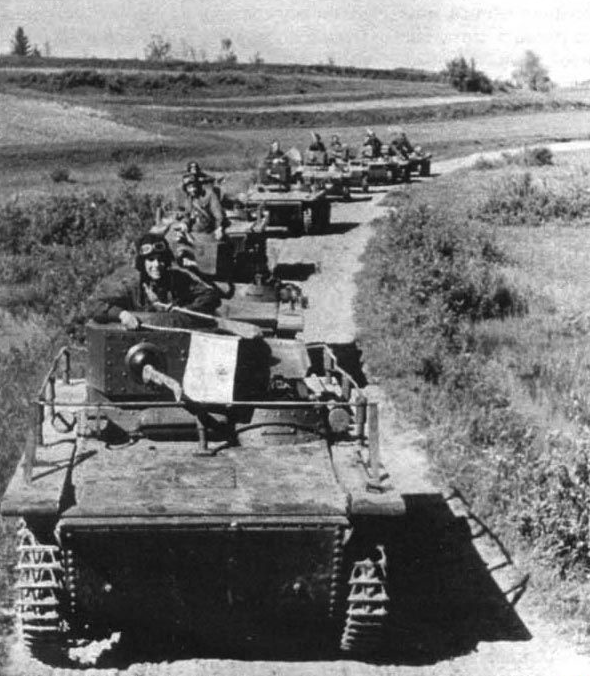
Tactical and technical characteristics of the floating tank T-37A:
Overall dimensions: body length - 3,73 m, body width - 1,94 m, height - 1,84 m.
Combat weight - 3,2 t.
Reservations - from 4 to 8 mm.
Engine power - 40 HP
Maximum speed - 40 km / h (on the highway).
Speed afloat - 6 km / h.
Power reserve - 230 km.
Armament - 1x7,62-mm machine gun DT.
In the turret of the floating tank T-37, it was proposed to replace the DT-29 machine gun, which was the main armament of the tank, with the ShKAS aviation machine gun. The main purpose of this replacement is to increase the combat power of the tank. It was originally developed as a reconnaissance vehicle, the same role was assigned to T-37A in the army. It was assumed that the tank would take part in sufficiently transient combat clashes with the enemy, in which the greatest role would be played by the maximum fire impact, which means greater rate of fire.
The design of the proposed ball mount SHKAS and small dimensions of the turret of the floating tank T-37А allowed the machine gun to be aimed in a horizontal plane (without turning the turret, which rotated 360 °) within the following limits: to the right 18 °, to the left 10 ° 30 '. If with horizontal guidance everything was more or less normal, then with pointing in a vertical plane, everything was worse. The machine gun could fire in the sector from −4 ° to + 22 °, which contributed to the creation of vast dead zones - it was simply impossible to hit targets near the combat vehicle, since the barrel almost did not go down, so the enemy’s infantry that came close to the tank could cause many troubles . There were no problems with sights. The T-37А was equipped with two sights: an optical sight "ПЯ" and a diopter sight, which was borrowed from the DT ball mount.
In the aviation versions of the ShKAS machine gun, the tape was fed from a box to 250 cartridges, in later versions - to 750 and 1000 cartridges. Some machine guns specially installed cartridge boxes on 1500 cartridges. In the T-37A tank, the machine gun was powered from a box of 750 cartridges. In addition, there was a supply of 2000 ammunition in the body of the combat vehicle. The full machine gun ammunition was 2750 ammunition in ribbons of 250 pieces, which were located inside the tank as follows: three ribbons were put in a box that directly fed the machine gun. And 2000 cartridges - in the box on 250 cartridges, which were inserted into a special lattice-holder with sockets on the 7 boxes. Another box with cartridges lay separately. The filing of cartridges from the box was carried out using a flexible metal sleeve, which was similar to that used in aviation. Such a device made it possible to provide uninterrupted power to the machine gun when firing with any aiming angles both in the vertical and in the horizontal plane.
The main difference between the ShKAS tank machine gun and the aviation machine gun was that, at the request of the GABTU specialists, it was transferred to a cloth tape instead of a loose metal tape. It was explained quite simply: it was easier to fill the tape of cloth with cartridges, and there was no need to collect the links that had scattered after the shooting into a special container. In addition, there was a risk that the loose tape links could accidentally end up in moving parts inside the tank, jamming them. To switch to the cloth tape, the receiver and feed of cartridges in the machine gun were changed.
According to the results of the tests, the experiment with the installation of the ShKAS machine gun in the turret of the T-37A amphibious tank was considered unsuccessful. A number of reasons stood out: the small corners of the vertical pickup of the machine gun, the low reliability of the cloth tape, which was sensitive to moisture, swelled and then exploded, caused distortions at such a high rate of fire. Work on eliminating these problems took a lot of time from the commander of a combat vehicle. But without any problems with the tape, the ShKAS machine gun turned out to be too complicated and inconvenient for the small and cramped turret of the T-37A tank. The military felt a lack and too high rate of fire of the machine gun. All ammunition could be shot literally 5 minutes of battle, even taking into account the time to replace the boxes. It was also noted that for ShKAS, special, more reliable cartridges were needed, which the Soviet industry could not provide in sufficient quantities both aviation and tank units.
One thing is for sure: installing a ShKAS machine gun with a 1800 fire rate of rpm / min on a floating tank could have a strong moral effect on the enemy. The famous single German machine gun MG-42 had a rate of fire at the level of 1200-1500 shot / min, depending on the shutter. It was terrible weaponwhich all opponents of Hitler Germany had to face, it was not without reason that it earned such nicknames as the lawn mower and Hitler’s circular saw. Soviet Aviation ShKAS surpassed him in the rate of fire. 1800 shots per minute is 30 shots per second. At the same time, the human eye perceives the image as smooth and continuous even at a frequency of 18 Hz or 18 frames per second. The 24 frame rate per second has become a common standard in movies. With an 1800 firing rate per minute and the use of tracer ammunition, a visual effect could arise where the shooting from the tank would be perceived by the eye as continuous rays reaching towards the enemy. When attacking tanks from the water at night, the effect would be especially strong.
Information sources:
http://warspot.ru/4902-nesostoyavshiysya-lazernyy-tank-rkka
http://www.airwar.ru/weapon/guns/shkas.html
http://tanki-v-boju.ru/tank-t-37a
Open source materials
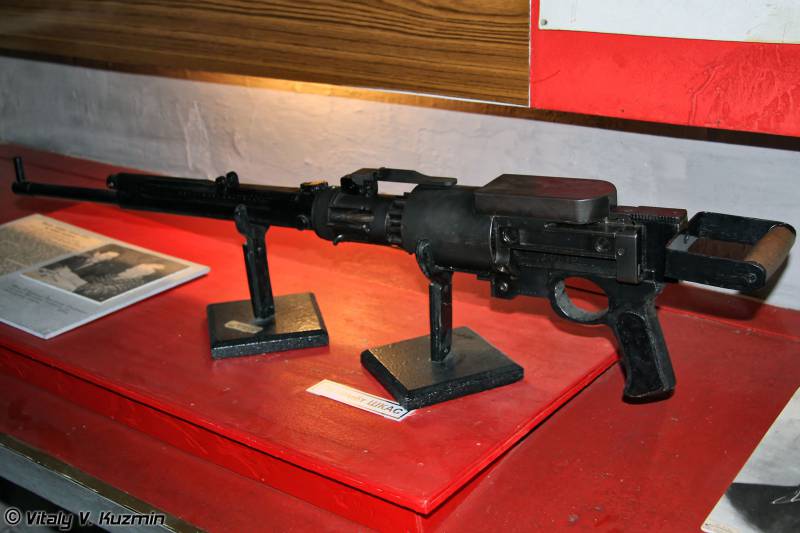

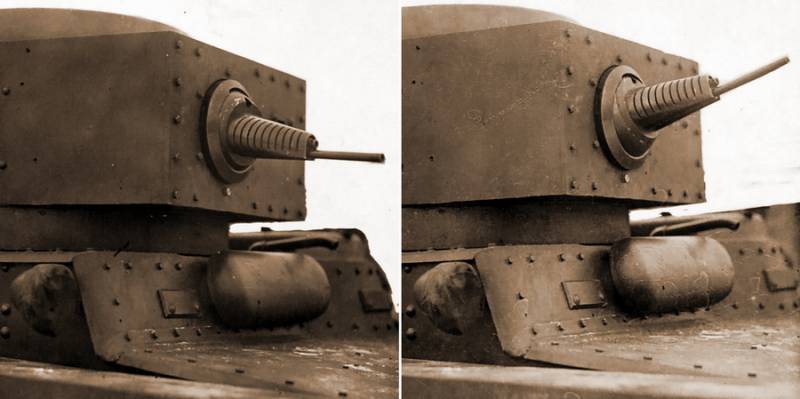
Information